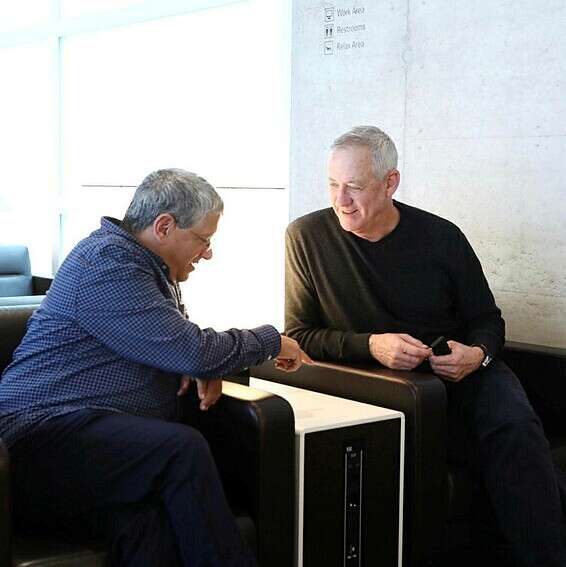From the flight course in 1979, through the airplane over Auschwitz to the Air Force Command at Eitan Cliff • This is what Amir Eshel's military career, Director General of the Interior Ministry, looked like
Amir Eshel
Photo:
Moshe Shay
Former Air Force commander Amir Eshel's appointment as Secretary of Defense under Defense Minister Benny Gantz was no surprise. As chief of staff, it was Gantz who insisted on appointing Eshel as commander of the Air Force, and during the election campaign, Eshel served as chairman's advisor Blue-white and even flew with him to Washington for a meeting with US President Donald Trump, Eshel's tenure as commander of the Air Force was very long - five years - and considered highly successful.
Eshel, 61, was born in Jaffa. At the age of 18, he enlisted in the Air Force's flying course, completing it in combat in 1979. He first flew the Skyhawks at Etzion and Ramon bases and served as a leader in the first Lebanon war. There was then an instructor in flight school and an operational training course for two years.
Throughout his service, he flew numerous aircraft and helicopters, including F-16 and F-15, Corners, Eagle, Apache, Cobra, Yasur and light aircraft, and accumulated thousands of flight hours. In 1991, he was appointed commander of Lightning Squadron at Ramat David Air Force Base. Two years later, he was appointed commander of the Cornas Squadron at Tel Aviv Air Force Base. In 1996, he was appointed head of operations at the Air Force headquarters, and was very prominent in his position.
In 1999, Eshel was appointed Ramon Base Commander in the Corps, and was involved in a difficult incident that only a miracle ended without casualties: During a routine training flight he flew with another pilot from the Apache helicopter, and the two performed an exercise in which to fire an ammunition launch pad in an empty area to make sure the aircraft was unarmed. . Much to their surprise, after a fight at the button, a missile that hit a hill not far from it was shot by several reservists.
Eshel was later promoted to Brigadier General and commanded the Tel Aviv Air Force base. In 2004, he was appointed as number three in the Air Force at the time, head of the Air Force. In 2006, he was previously head of the corps, and served in that position even during the Second Lebanon War. During this position, the Air Force also attacked the Syrian nuclear reactor in Deir a-Zor.
Eshel lost the title of commander of the Air Force to Ido Nehushtan at that time, and was appointed head of the IDF's Planning Division. In 2010, Eshel was appointed commander of the Air Force by Gantz, the chief of staff at the time, who insisted on appointing him. He resigned as Air Force commander in August 2017, after 40 years of service in the IDF and in the Air Force, after the Chief of Staff Eisenkot extended his tenure to five years.
During his years in command of the Air Force, Eshel revolutionized the organization and operations in the Corps. During his time, the IDF embarked on secret military operations (the interwar war), some of which were published in foreign media as Israeli attacks in Syria and other targets. In a farewell interview to Haaretz, Eshel said that Israel has attacked nearly 100 times weapons convoys for Hezbollah and other organizations in its five years of service. Eshel also commanded the Air Force in operations "Cloud Pillar" and "Solid Rock" in the Gaza Strip, and made a significant upgrade of the air force's offensive capabilities.
Eshel even changed the organizational structure of the Air Force and established the operational headquarters to increase the operational output of the corps by hundreds of percent. During his time, new technologies and new aircraft, such as the mighty aircraft (F-35i), and the Samson aircraft, the Super Hercules as the advanced carrier aircraft of the Corps, were also absorbed in the Air Force. During his tenure, Eshel also changed the structure of the air defense system, and absorbed the "Sling David" system (magic wand) to intercept rockets and missiles in the medium term. In addition, the capabilities of the Iron Dome system have been enhanced.
Eshel ended his role in the slightly jarring chord with an Apache helicopter accident in which the Reserve Air Force pilot was killed and another pilot was seriously injured.
One of the most recognizable stories with Eshel during his military service was actually a non-operational flight over the Auschwitz-Birkenau camp in 2003. Eshel was the one who conceived and even led the idea of holding the Mets. The Mets picture appears in many bureaus of state and military officials, partly because former Air Force commander Eliezer Shkedi distributed the picture as a farewell gift.
Eshel graduated with a bachelor's degree in general studies from Auburn University in Alabama, and a master's degree in political science from the University of Haifa and the National Security College. He is married to Abigail and the father of Inbar, Yoav and Uri.

